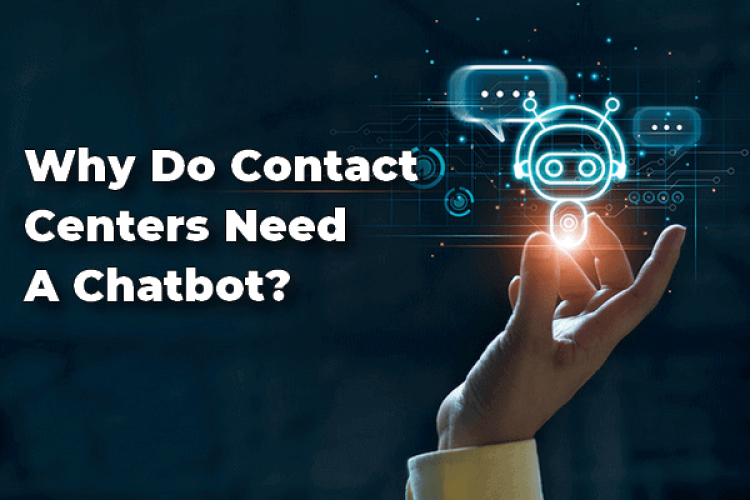Mobility, flexibility, automation… the development of chatbots is the inevitable result of a ten-year technological convergence that has swept across all companies and contact centers. The chatbot, as a conversational robot embedded into a messaging app, enables the creation of a new communication experience with users.
A chatbot is a conversational tool that provides information to users. The installation of a chatbot as part of a company’s digitization strategy offers several advantages. How does a chatbot function? Why is it vital for a business? What are its advantages for contact centers? We answer it all, in this article.
What is a chatbot?
 A chatbot, also known as an intelligent virtual agent, is a program that can do activities independently while communicating with humans over a communication channel. At the user’s request, the chatbot can, for example, execute a search or initiate an automated operation. In general, it communicates with individuals using natural language.
A chatbot, also known as an intelligent virtual agent, is a program that can do activities independently while communicating with humans over a communication channel. At the user’s request, the chatbot can, for example, execute a search or initiate an automated operation. In general, it communicates with individuals using natural language.
In simpler words, A chatbot is an intelligent conversational robot that may assist a contact center in the following ways:
- Answer the most frequently asked questions
- Improve response times
- Free up agents for more critical work and lower the number of call center personnel.
According to a recent Juniper Research estimate, chatbots will have 22 billion contact centers with customer interactions by 2023.
The development of chatbots shares many similarities with that of mobile and web apps. It does, however, have unique traits that must be addressed. So, here are a few things to bear in mind if you want to handle this communication channel effectively.
Why do call centers need a chatbot?
Typically, contact centers would use a chatbot to increase sales or improve customer service via messaging services or boost their communication channel presence.
However, this virtual agent can execute some jobs better than other interfaces. It may, for example, give consumers personalized advice, manage recurrent requests, and automate customer care chores.
As a result, it is critical to carefully specify with your supplier the various features you need from your chatbot.
The important things to remember are that:
- Chatbots help you to take new customers.
- Chatbots keep your customer satisfaction high by listening to customer complaints and responding with ease.
- Chatbots are time and labor savers for contact centers
- Chatbots can make it easy to talk to customers who are angry and ask them to identify their problem
- Chatbots are powerful
Chatbots are not magic. But, a chatbot can help a business solve issues in a more personalized way, as opposed to a typical auto-response. A chatbot is much better than an automated response, as it adapts to the words of the user.
This is because a person who is not expecting the chatbot can sometimes respond with a good response. But a chatbot can respond in a more personalized and professional way, as it will respond to people without a pre-defined preset response.
- Chatbots are extremely flexible
A chatbot does not necessarily need to be in the form of a chat, it can be a text message, as well a voice (which would look similar to SMS), or even a voice command.
- Chatbots are cheaper to buy
No fancy smarts, no automation, no extra complicated stuff. A chatbot just needs to be able to know who is being called, and who it is being called from, to look up the companies or products.
- Chatbots are good at customer service
Chatbots can handle thousands of customers at once and answer questions that are considered difficult, complex, or unreasonable to answer. A customer service representative can’t handle these questions as well.
 Do Chatbots Improve the Customer Experience? Shep Hyken Customer Service & Experience Expert has the answer for you.
Do Chatbots Improve the Customer Experience? Shep Hyken Customer Service & Experience Expert has the answer for you.
It’s a common question among customer service professionals: do chatbots improve or degrade the client experience? Shep, on the other hand, has some ideas on the subject. He seemed to imply that there is a lot of potential for both good and harm when employing chatbots.
Advantages of using Chatbots in a Contact Center
The growth of chatbots is a direct result of the convergence of mobility, automation, and social media that has taken place in all businesses over the past 10 years. The chatbot is a conversational robot that can be put into a messaging app or a website to offer a brand-new communication channel and customer experience for consumers.
Chatbots increase customer engagement
Chatbots may have real-time discussions and answer quickly. They are far superior to phone trees, which compel callers to wait for an extensive list of requests and are quite limiting in terms of comprehension.
This immediate touch is what drives client engagement on any website. Responsive chatbots on businesses’ websites that are rich with data may be of tremendous assistance to your clients, whether it’s giving product recommendations or guiding them through your site.
Customers enjoy quickness and convenience, especially when they are in a hurry. According to studies, users are more inclined to interact with chatbots when they have an emergency or want a speedy answer.
If your chatbot is in the right location at the right time, you will be able to have a direct influence on your consumers’ buying experience.
Contact center agents’ tasks Automation
Chatbots ar e not intended to replace your agents, but they do make wonderful assistance.
e not intended to replace your agents, but they do make wonderful assistance.
A chatbot can automate tasks like booking appointments and delivering reminders. Several businesses have indicated that chatbots have assisted them in lowering customer service expenses and improving response times by handling even the most basic questions.
Chatbots may now handle a variety of additional tasks, such as sending or receiving emails on your behalf, collecting and verifying contracts, monitoring shipping status, and canceling or placing orders.
However, one of the most significant advantages of automation is the ability to collect feedback. Unsatisfied consumers will most likely depart your firm without informing you, robbing you of any opportunity to rectify the situation.
An Omnichannel presence
Contact center nowadays must modify their strategies to be accessible across all communication channels, the number of which is increasing. At the same time, they must improve their responsiveness and efficiency by offering a more seamless purchasing experience to customers.
Another advantage of a chatbot is that it may be released on many channels at the same time (instant messaging, mobile applications, websites, etc.). You will be able to be there where your clients are and obtain all of the information you need to better understand their purchasing behavior as a result of this (comments, complaints, purchase plans, etc.).
This data will enable your staff to give a close-by service or to continually enhance their services.
Consumers will benefit from a seamless omnichannel in contact centers. since they will be able to access the same services and information regardless of the channel utilized. Furthermore, they will have more freedom in selecting which communication strategies to utilize. This adaptability is also essential if you want to establish a good customer experience.
Managing massive amounts of data
The chatbot can swiftly assess a vast volume of customer data and highlight the most pertinent elements based on the context of the request. In this sense, it might motivate human agents to prioritize more difficult and essential activities over ordinary, frequently time-consuming chores.
Finally, keep in mind that chatbots may be built with a variety of conversational styles, ranging from simple technical help to a discussion that mixes professionalism, warmth, and even humor.
You may provide a more human experience to your clients by developing a conversational robot that employs natural language and can talk in a customized manner. As a consequence, customers will have a more positive experience and will not hesitate to contact your organization again if necessary.
Your average waiting times are down to 0
“Your call average wait time is expected to be…”: the line that irritates and annoys users has ended. Access to information is direct, responsive, efficient, and without waiting using a chatbot. The system can manage thousands of users at once and answer the same questions as many times as necessary, all while maintaining the same degree of professionalism and empathy. For users, having rapid access to customer support through a smartphone provides them the comfort that they are being heard and makes their demands more fluid.
Even if the chatbot is unable to answer the query, information is transmitted directly to a person, and the support service will contact the consumer based on his limits. For a covert and silent discourse, the contact can be made via phone, messaging app, or chat interface.
Self-improvement and advancement
While most chatbots adhere to pre-programmed scripts, some employ artificial intelligence and specialized algorithms. The idea is for chatbots to become increasingly powerful and valuable as they are utilized. They can deliver better services and engage with a much finer degree of understanding when combined with business tools.
Advances in artificial intelligence and machine learning are gradually propelling chatbots to previously unheard-of levels of capability, allowing them to go beyond the fundamental inquiries for which they were created. To respond to this intelligence, and organized and up-to-date knowledge base is required.
How to Implement a Chatbot in your contact center?
Step 1: Define your Framework
 It is by no means about adopting a chatbot just because it is the trend in contact centers. As a contact center Owner, you need to define and justify your choice by your business goals. First of all, it should address the issue of availability. A good service is first and foremost available 24 hours a day, 7 days a week.
It is by no means about adopting a chatbot just because it is the trend in contact centers. As a contact center Owner, you need to define and justify your choice by your business goals. First of all, it should address the issue of availability. A good service is first and foremost available 24 hours a day, 7 days a week.
On the other hand, and for the sake of performance, you should integrate a virtual agent within your system. This allows your chatbot to quickly handle small tasks while reducing the cost of phone calls ( For example: managing high volume phone calls, answering simple demands, etc.) This way, your agents will have more time to focus on high-value or urgent requests.
Finally, a virtual agent can improve the image of your customer service platform by streamlining your digital and omnichannel interactions. Whatever your reasons for integrating a chatbot within your contact center. The most important thing to remember is to define your business goals in advance.
Step 2: Data is Everything!
The virtual agent is not a simple assistant; it is a machine that learns with time. In other words, as it interacts with your customers, this system will enrich its database and improve the answers it can give them.
But before all that, you still need to design your Chatbot, by having a database on which it will rely. In this sense, you must focus your efforts on the experience of your existing customers. For example, make an analysis of their current needs, their consumption habits, the most common queries, or their buying behaviors. It all depends on the nature of your campaign.
Of course, it doesn’t mean you need to have absolute and perfect knowledge of your customers from the get-go. Your database will be limited at the start, but over time you can improve your process and create more engaging conversations.
Step 3: Testing and Training
There is no technology without testing. Even if you have the most powerful and advanced Chatbot on the planet. It is vital to put your new virtual agent to the test, looking for every possible twist and turn to questions and requests your customers might ask.
Once evaluated live, make the necessary adjustments so that your virtual agent doesn’t deceive your customers. Be proactive and always think about improving your technology.
Now that your virtual agent is up and running, plan the deployment in order to run within your contact center system. That is to say that the implementation must be progressive and must be integrated into your CRM, one element at a time.
Keep in mind that, a virtual agent deployed in a hurry can quickly affect the image of your teams and obliterate a good customer experience.
Step 4: Your Customers’ Opinions Matter
Have you successfully integrated your virtual agent? Your mission is not done yet. You still need to ask for feedback from users and customers.
Simply, did they notice any bugs? Is the tool simple to use? Does it allow you to redirect urgent requests to your agents? Negative or positive feedback will allow you to improve your virtual agent.
Step 5: Your Agents Matter too
What makes great decision-makers and thinkers of tomorrow is the interest in blending perfectly human efforts and artificial intelligence. Agent interaction remains more than ever vital to complete customer satisfaction.
Therefore, your agents should not be an endangered model of work, as it is most of the feared with contact centers. On the contrary, it would be a profession in the making, dedicated to increasing their skills to work perfectly with your artificial intelligence. This omnichannel approach allows you not only to provide a complete response to all your customers. But also to boost your key performance indicators.
Step 6: Measure the Performance of your Virtual Agent
Key Performance Indicators in contact centers are not exclusive to your agents. Indeed, thanks to your dashboards you can monitor the activity of your virtual agent and extract all the numbers you need.
Some of the most used KPIs are:
- The number of calls handled,
- Lost calls,
- The level of users’ understanding,
- Average call processing time.
Of course, KPIs are not the same for all chatbots. You can determine the most relevant ones according to the nature of your activity and the goals of your campaigns.
Step 7: Choose Wisely your Provider
Unfortunately, there are still vendors who claim to provide virtual agents that simply react based on keywords. A real chatbot is above all, a virtual intelligence and not a virtual assistant. Therefore, it must understand, interpret and analyze the meaning of the customer’s request.
If the proposed virtual agent seems to be based on predefined programming and scripts or if it only provides automated answers, then be wary. It is imperative that your provider has the skills and proven experience in the field. Which includes expertise in natural language processing and comprehension, UX bot designers, bot trainers, etc.
How to evaluate Chatbot performance in a call center and what KPIs to follow?
Chabot’s are useful and convenient for solving easy customer requests. However, many brands still encounter problems in their deployments. The reason is a lack of call center strategy to measure chatbots’ effect on customer experience. In other words, there is a need to pinpoint metrics and KPIs that are most relevant to the effectiveness of this communication channel.
Which Chatbot KPI Do You need to Follow?
When it comes to KPIs, even the most knowledgeable contact center experts can get lost in them. To help you, here are the 5 most critical indicators in your evaluation of this communication channel.
1 – Activation Rate
 Before you can quantify the effectiveness of your Chatbots. You must first make sure that customers are using it. Hence the role of the activation rate, which accurately determines the extent to which your customers use the Chatbots channel for the first time. This KPI is calculated monthly and allows you to determine the new, most active, and engaged users.
Before you can quantify the effectiveness of your Chatbots. You must first make sure that customers are using it. Hence the role of the activation rate, which accurately determines the extent to which your customers use the Chatbots channel for the first time. This KPI is calculated monthly and allows you to determine the new, most active, and engaged users.
In addition, if you compare the total number of users with the volume of requests or sales handled by all of your customer service channels, you will have a better idea of the effectiveness and visibility of the tool as a communication channel.
2 – Retention Rate
The next step is to determine how many customers are returning to the chatbot. Whether it is monthly, quarterly or annually, you can accurately determine the percentage of customers using your communication channel after their first use. Based on this percentage called retention rate, you can see if the level of investment in chatbots is a sustainable option for your contact center. If not, you will have to make major technological changes.
It should be noted that a customer who comes back often to the Chatbot may be a customer whose problem has not been solved. Or he may simply prefer it as a communication channel. Data analysis should therefore be done sparingly.
3 – Response time
As they say, time is money. A recent study revealed that 62% of Americans prefer chatbots as a method of communication. Why? Simply because they can answer their questions and requests quickly. So it is important for your contact center to ensure that your conversational robot can respond instantly to users.
It doesn’t stop here! Your communication channel must not only provide solutions that best solve your customers’ concerns. But also to quickly refer to an agent in a fluid and attractive way. Measuring the response time for each customer is a key factor in evaluating the effectiveness of the technology.
4 – Confusion Rate
Technology is not perfect! Confusion rate refers to the percentage of exchanges during which the chatbot will be disturbed when it has to respond to an unexpected request. Even if the mechanics of your artificial intelligence are well optimized, it is likely to derail. In this case, the client exchange should be redirected to agents.
But be aware that the rate of confusion can be significantly reduced. You can do this by improving the programming and training of your chatbot before and when you use it.
5 – Customer Satisfaction
This Key Performance Indicator is a simple answer to a simple question. Do your clients like your chatbot?
The solution is even more simple, you can ask clients to rate their experience after finishing their interactions. Make sure that each exchange can be rated by your customers. The best example would be implementing a 5-star rating system or a 1 to 5 scale.
6 – Volume of activity
Measuring the level of activity entails assessing the number of encounters with a chatbot, ranging from a basic query posed by the user to a meaningful debate. This indication enables you to answer two important questions.
- Is your chatbot often used?
- Is there an increase in the number of users?
There are two ways to use it:
- Users who interact with your chatbot on their own initiative; users who interact after getting a notice.
- The rate of voluntary usage is a good measure of your conversational agent’s popularity. It also helps you to ensure that your chatbot is correctly placed in the consumer experience.
7 – The average number of contacts
Allows for the evaluation of the Customer Effort Score on the chatbot, which should be associated with the Satisfaction Rate. If the latter is really low, the bot may be involving consumers in too many branches and processes to satisfy their demands. In this circumstance, one option is to modify the design of the decision trees or the knowledge base.
These various KPIs are not the only ones that can be used to assess the added value of your chatbot in relation to your initial campaign goal. It appears evident that frequently checking them will assist you in improving the solution’s efficiency.
They should not, however, be the only factors considered when assessing the overall impact of the solution. Until recently, call centers did not require artificial intelligence to establish exceptional client connections or optimum customer journeys.
Chatbot: Mistakes you should avoid
Managers and supervisors must be careful not to overestimate a chatbot’s powers, especially seeing it as an omniscient genie directly coming from a magic lamp. It is advisable, at least initially, to limit the scope of your intelligent conversational agent to the following topics:
- Customer service for an extraordinary offer, delivery follow-up, sales advice, and so forth.
- A project that is overly ambitious increases the likelihood of failure and can decrease your level of client satisfaction.
Ignoring all forms of personalization
 With the growing usage of bots, free or commercial pre-programmed templates have proliferated on the Internet, frequently promising to change your customer service.
With the growing usage of bots, free or commercial pre-programmed templates have proliferated on the Internet, frequently promising to change your customer service.
These templates may be really intriguing, and they can help you save a lot of money on the initial design and development effort. However, there is one condition: you must have in-house developer expertise to take over the code, alter it, and adapt it to the unique requirements of your organization.
Such a chatbot is too generic and will not be of any use to you, and may even harm your brand image.
Predefined scripts should be avoided
When chatbots are improperly built, i.e. when they are based on predetermined scripts, they might ruin opportunities for your prospects or clients.
Because their database does not enable them to supply new words, some chatbots can only provide the same replies. Others simply cannot answer simple inquiries because their designers failed to account for the reality that customers may ask surprising, even nonsensical queries.
To offer the chatbot more flexibility, the approach is to depend on artificial intelligence and machine learning. The chatbot will be able to deliver customized replies in real-time thanks to these technologies and the data it has gathered from client interactions.
Don’t overlook security and data protection
As you are well aware, a chatbot requires a large amount of information about your clients in order to answer their inquiries.
This information, however, can be important and must be kept secure. Remember what happened with Microsoft chatbot Tay?
Because the chatbot is your customer experience ambassador, such a circumstance might be disastrous, especially if you combine your chatbot with your CRM software or web server. Inquire with your chatbot provider about how they handle this and other types of issues.
The future of Chatbots in Contact Centers
Deploying a chatbot in a contact center is no longer a futuristic concept. It is now a tangible reality. And, yes, the moment has come to change your traditional call center into a multi-channel contact center staffed by professional operators who will be assisted by intelligent solutions such as chatbots or CRM.
The contact center will become more efficient as a result of these clever tools. It will be simpler to evaluate unstructured incoming data (audio or video), to respond to difficult inquiries via social networks, and provide virtually human-like responses.
The most essential thing to remember in the future is that chatbots will never be able to replace your agents. They must work together. They can, for example, assist telephone advisers in providing the correct response in the shortest amount of time. This is an excellent chance for your contact center to combine human and technological resources.
Our Cloud Contact Center Solution, NobelBiz Omni+, provides not only a platform that can be seamlessly linked with most CRMs, but also a solution that can consolidate all communication channels (telephone, social media, webchat, and SMS) into a single, unified, and true Omnichannel platform.
Furthermore, our voice carrier network is one of the most modern call center voice services available, with worldwide coverage and redundant servers that provide 99.99% uptime. Furthermore, it is a network that is:
- Integrated with the most advanced productivity tools ( IVR, ACD, Local Number ID Management, compliance filters, and more)
- Specifically designed to meet the needs of the call center sector.
- The market’s most sophisticated communications network.
- Infrastructure that is one-of-a-kind and dependable, with several redundancies.
- In terms of cost per minute, this is the most competitive telecom provider.

Abdelmounim Benharouga has always had a strong passion for writing and digital marketing. He started as a Digital Content Writer part of marketing department then moved to being Customer Success Manager for the African Region within the Nobelbiz team.


